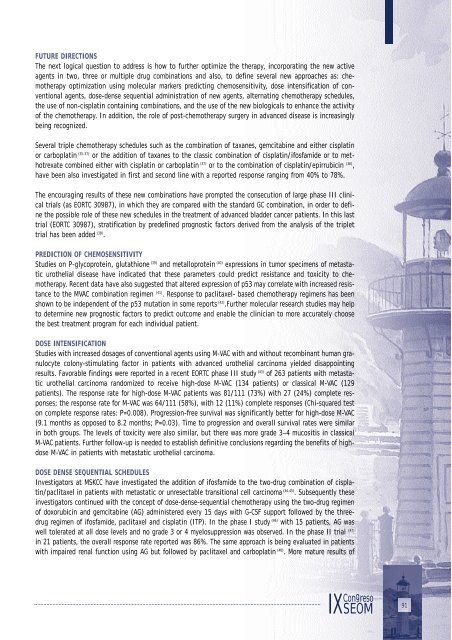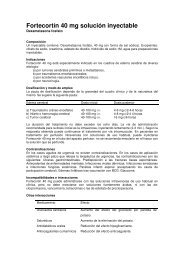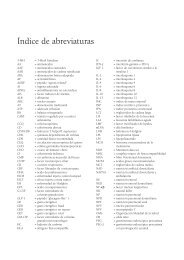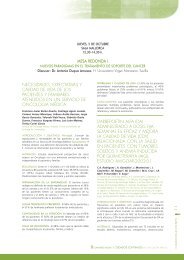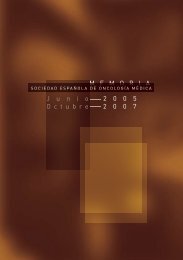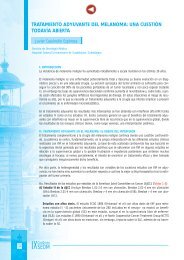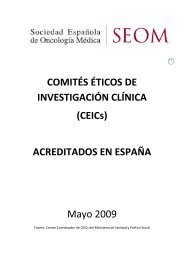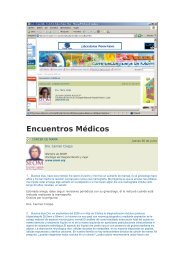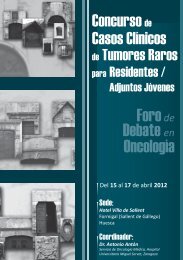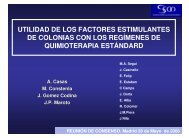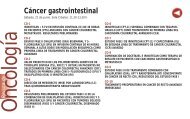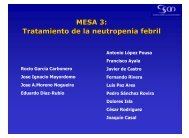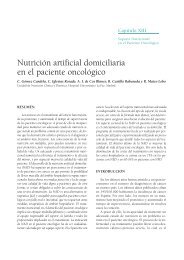Resúmenes de Ponencias - Sociedad Española de OncologÃa Médica
Resúmenes de Ponencias - Sociedad Española de OncologÃa Médica
Resúmenes de Ponencias - Sociedad Española de OncologÃa Médica
Create successful ePaper yourself
Turn your PDF publications into a flip-book with our unique Google optimized e-Paper software.
FUTURE DIRECTIONS<br />
The next logical question to address is how to further optimize the therapy, incorporating the new active<br />
agents in two, three or multiple drug combinations and also, to <strong>de</strong>fine several new approaches as: chemotherapy<br />
optimization using molecular markers predicting chemosensitivity, dose intensification of conventional<br />
agents, dose-<strong>de</strong>nse sequential administration of new agents, alternating chemotherapy schedules,<br />
the use of non-cisplatin containing combinations, and the use of the new biologicals to enhance the activity<br />
of the chemotherapy. In addition, the role of post-chemotherapy surgery in advanced disease is increasingly<br />
being recognized.<br />
Several triple chemotherapy schedules such as the combination of taxanes, gemcitabine and either cisplatin<br />
or carboplatin (35-37) or the addition of taxanes to the classic combination of cisplatin/ifosfami<strong>de</strong> or to methotrexate<br />
combined either with cisplatin or carboplatin (37) or to the combination of cisplatin/epirrubicin (36) ,<br />
have been also investigated in first and second line with a reported response ranging from 40% to 78%.<br />
The encouraging results of these new combinations have prompted the consecution of large phase III clinical<br />
trials (as EORTC 30987), in which they are compared with the standard GC combination, in or<strong>de</strong>r to <strong>de</strong>fine<br />
the possible role of these new schedules in the treatment of advanced blad<strong>de</strong>r cancer patients. In this last<br />
trial (EORTC 30987), stratification by pre<strong>de</strong>fined prognostic factors <strong>de</strong>rived from the analysis of the triplet<br />
trial has been ad<strong>de</strong>d (38) .<br />
PREDICTION OF CHEMOSENSITIVITY<br />
Studies on P-glycoprotein, glutathione (39) and metalloprotein (40) expressions in tumor specimens of metastatic<br />
urothelial disease have indicated that these parameters could predict resistance and toxicity to chemotherapy.<br />
Recent data have also suggested that altered expression of p53 may correlate with increased resistance<br />
to the MVAC combination regimen (41) . Response to paclitaxel- based chemotherapy regimens has been<br />
shown to be in<strong>de</strong>pen<strong>de</strong>nt of the p53 mutation in some reports (42) .Further molecular research studies may help<br />
to <strong>de</strong>termine new prognostic factors to predict outcome and enable the clinician to more accurately choose<br />
the best treatment program for each individual patient.<br />
DOSE INTENSIFICATION<br />
Studies with increased dosages of conventional agents using M-VAC with and without recombinant human granulocyte<br />
colony-stimulating factor in patients with advanced urothelial carcinoma yiel<strong>de</strong>d disappointing<br />
results. Favorable findings were reported in a recent EORTC phase III study (43) of 263 patients with metastatic<br />
urothelial carcinoma randomized to receive high-dose M-VAC (134 patients) or classical M-VAC (129<br />
patients). The response rate for high-dose M-VAC patients was 81/111 (73%) with 27 (24%) complete responses;<br />
the response rate for M-VAC was 64/111 (58%), with 12 (11%) complete responses (Chi-squared test<br />
on complete response rates: P=0.008). Progression-free survival was significantly better for high-dose M-VAC<br />
(9.1 months as opposed to 8.2 months; P=0.03). Time to progression and overall survival rates were similar<br />
in both groups. The levels of toxicity were also similar, but there was more gra<strong>de</strong> 3–4 mucositis in classical<br />
M-VAC patients. Further follow-up is nee<strong>de</strong>d to establish <strong>de</strong>finitive conclusions regarding the benefits of highdose<br />
M-VAC in patients with metastatic urothelial carcinoma.<br />
DOSE DENSE SEQUENTIAL SCHEDULES<br />
Investigators at MSKCC have investigated the addition of ifosfami<strong>de</strong> to the two-drug combination of cisplatin/paclitaxel<br />
in patients with metastatic or unresectable transitional cell carcinoma (44,45) . Subsequently these<br />
investigators continued with the concept of dose-<strong>de</strong>nse-sequential chemotherapy using the two-drug regimen<br />
of doxorubicin and gemcitabine (AG) administered every 15 days with G-CSF support followed by the threedrug<br />
regimen of ifosfami<strong>de</strong>, paclitaxel and cisplatin (ITP). In the phase I study (46) with 15 patients, AG was<br />
well tolerated at all dose levels and no gra<strong>de</strong> 3 or 4 myelosuppression was observed. In the phase II trial (47)<br />
in 21 patients, the overall response rate reported was 86%. The same approach is being evaluated in patients<br />
with impaired renal function using AG but followed by paclitaxel and carboplatin (48) . More mature results of<br />
Congreso<br />
IXSEOM<br />
91


